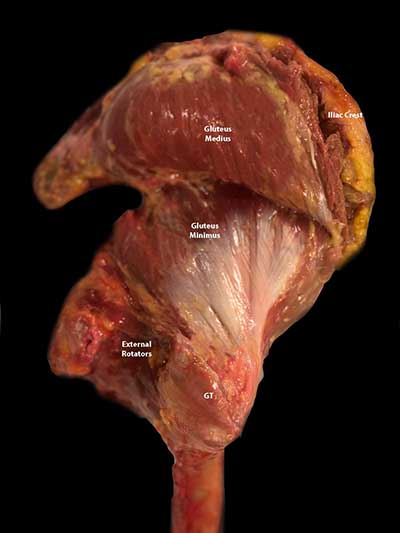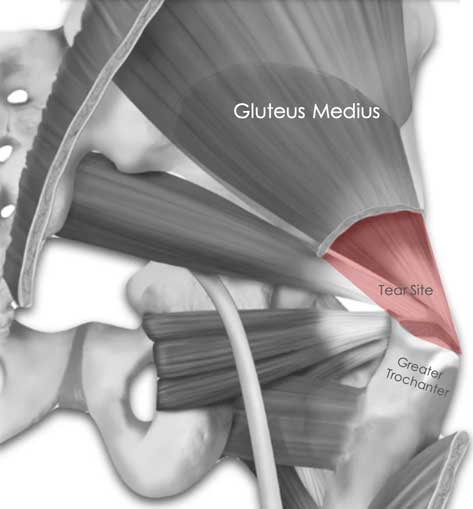Gluteus Medius FAQ
Function of the Gluteus Medius Muscle?

The hip is a ball-and-socket joint that connects the femur (thigh bone) and the acetabulum(within the pelvis). This joint is crucial for weight-bearing and is supported by many muscle groups, including the gluteus medius. The gluteus medius and gluteus minimus muscles are some of the crucial muscles for pelvic stability, abduction of the leg (movement away from your body),and internal rotation of the hip. This muscle originates in the ilium (upper part of the pelvis) and runs through the greater trochanter (the bony prominence of the hip). The gluteus mediusis crucial for walking, running, and single-leg weight-bearing because it stabilizes the pelvis, allowing for an even gait.
What Causes Gluteus Medius Tears?

Tears of the gluteus medius are typically found at the tendon connecting the muscle to the femur(thigh bone). Gluteus medius tears are commonly observed in older patients (over the age of 50)or younger, active patients, such as athletes. In older and less active patients, these tears can begin from a condition known as trochanteric bursitis, which is characterized by chronic inflammation of the gluteus medius and gluteus minimus. This inflammation can progress to the point of causing a partial or complete tear of the gluteus medius. For younger and more active patients, gluteus medius tears can be caused by repeated use of the hip flexor muscles; as such, this injury is commonly observed in runners.
Different Tear Severities?
The severity of gluteus medius tears can be categorized by 3 separate grades as follows:
- Grade 1 Tear: patient experiences mild pain and little to no loss of mobility or strength.
- Grade 2 Tear: patient has a partial tear with mild pain and some loss of mobility and strength
- Grade 3 Tear: patient has a complete tear of the gluteus medius tendon and complete loss of mobility and strength.
- Grade 4 Tear: patient has a complete tear of the gluteus medius tendon and retraction of the muscle, potentially leading to muscle atrophy. Complete loss of mobility and strength is also present.
The grade of the gluteus medius tear will often inform the treatment options and prognosisprovided by the physician.
Symptoms of Gluteus Medius Damage?
Given its location in the lateral pelvic region, the most common signs of gluteus medius tear include the following:
- Pain on the outside of the hip.
- Lower back pain.
- Buttocks pain.
- Abnormal gait (or walking pattern).
- Issues with prolonged standing or side-sleeping.
It is important to note that patients often mischaracterize pain stemming from damage to the gluteus medius as originating from their lower back. All chronic pain in the hip region or prolonged issues with mobility and gait should be discussed with your physician as soon as possible.
How is A Gluteus Medius Tear Diagnosed?
Tears of the gluteus medius will typically be diagnosed by Dr. Jorge Chahla in the clinic through a thorough examination of the patient’s medical history and a physical examination. By strength-testing the region, Dr. Chahla will be able to determine whether your hip pain is being caused by gluteus medius damage or through another condition. Gluteus medius tendon tears are typically characterized by an uneven gait and a misalignment of the pelvis on the contralateral side of the tear to compensate for the tear during weight-bearing. If a physical exam suggests that a gluteus medius tear is likely, Dr. Chahla will order imaging tests–including X-rays and MRIs–to confirm the diagnosis and potential treatment options.
What Are My Treatment Options?
If Dr. Jorge Chahla determines that the patient has sustained a tear in the gluteus medius, the treatment options will be determined by the severity and extent of the injury. Occasionally, smaller, partial tears can be treated through the following:
- NSAIDs (non-steroidal anti-inflammatory medications).
- Physical Therapy to strengthen the region and regain mobility.
- Activity Modification to prevent further damage to the region.
- Assistive Devices (eg. canes or crutches) to reduce load to the damaged muscle/tendon.
For advanced partial tears or complete tears (Grade 3), surgery will likely be recommended to reattach the gluteus medius tendon to the greater trochanter. If a complete tear has been neglected for a prolonged period of time, this can lead to muscular retraction and atrophy of the gluteus medius. In such cases, allografts can be used to augment the repair tissue. Apart from this, a transfer of the anterior portion of the gluteus maximus to the greater trochanter may be preferred as a salvage approach in these cases. For this reason, if you believe you may have sustained a gluteus medius tear, contact your physician as soon as possible!
At a Glance
Dr. Jorge Chahla
- Triple fellowship-trained sports medicine surgeon
- Performs over 500 surgeries per year
- Assistant professor of orthopedic surgery at Rush University
- Learn more


